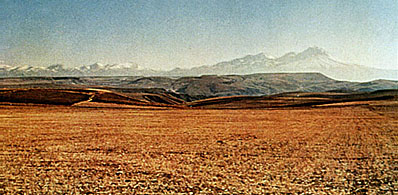

Click HERE to see a brief animation of recent glacial movements.
Click HERE to see how the last glacial retreat, starting about 12,000 years ago, affected the the climate of the region now called the Near East.
Agriculture also emerged in several other regions around the world somewhat later, as other human communities made the same kinds of discoveries and evolved similar cultural adaptations. These regions include the north China plain, in south and southeast Asia, in sub-Saharan Africa, in North and South America. Scholars debate whether all of these regions came to the discovery of agriculture independently or as a result of knowledge diffused from other cultures. They also debate whether the changes were driven by climate change or population pressures. Frequently, the available evidence is inconclusive.
In any case, for the past 10,000 years, agriculture has spread over the globe and evolved and assumed many forms, depending on the plants and animals available locally and the ability of imported life forms to adapt to new conditions. Agriculture as a mode of life has been enriched by many discoveries and inventions around the globe, and by borrowing techniques and crops and domestic animals from other regions. Gradually, sedentary agriculture became the dominant mode of life in nearly all of the areas of the world inhabited by humans. In addition, it formed the basis for a new way of life which we call civilization.
| Previous Page | Next Page | Ag Rev Home |